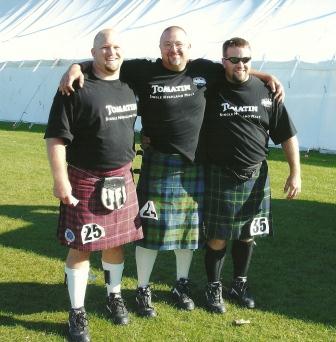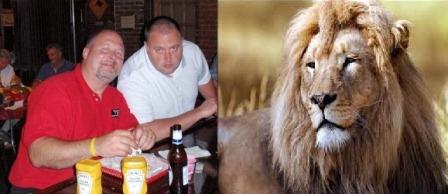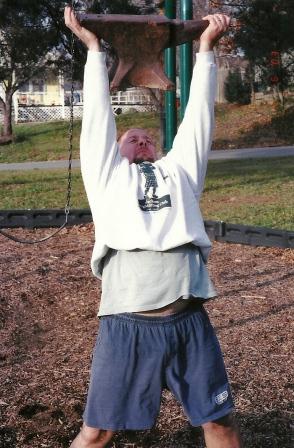Ban the Spin
by Thom Van Vleck
(Webmaster’s notes: The following is an editorial written by Thom Van Vleck 10 years ago in the Braemar Stone Tablet regarding his dislike of the spin in the Highland Game height events. I found this editorial very ironic and humerous on so many levels because since then Thom has totally changed his tune and is now an advocate for the spin. He has used the spin in the 42# WOB to set a World Record and numerous game records. But he sure gives a good argument why the spin should be banned!!!! How does it feel Thom to have to EAT YOUR WORDS??????)
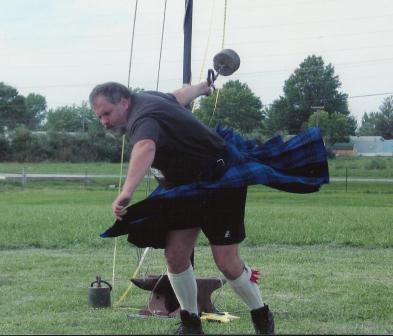
Thom Van Vleck utilizes the spin in the Weight Over Bar to perfection. In 2005, Thom set the All-Time World Record in the 42# WOB with a toss of 20'6". He has won or tied in the WOB at 3 World Championships (2004, 2007, and 2010). (photo credit Kevin Viet)
Recently, there have been some innovations in technique in the highland games. Namely, the spin on the sheaf and WOB. I have talked to a great many people about this and want to make their voices heard and to give my own opinion. You don’t have to like it, or even agree, but I think this is something we need to address before it goes too far.
A couple of years ago we began to see a few guys spinning on the sheaf. This year Harrison Bailey (I think) began spinning on the WOB. This has started to push some records up, and will no doubt continue to do so. I am opposed to the new techniques on several grounds.
First, they are dangerous. About a hundred years ago a woman was struck and killed in Canada by a wayward hammer. The man that threw it was so despondent he never competed again. I know how I would feel if I were responsible for a tragic accident. I would feel just as responsible as an Athletic Director who allowed unsafe practices to go on. It was also around that time that there was an innovation in technique. The athletes began to spin with the hammer. Yes, much like the Olympic hammer, the athletes would spin and throw the hammer. However, they quickly realized how dangerous this was and the practice was stopped. I feel that spinning with the sheaf could lead to serious injury as I witnessed Mike Smith flatten a metal chair with a wayward sheaf toss (old style) in McPherson a couple of years ago. A twenty pound sheaf could seriously hurt an adult and kill a child. I won’t even go into what a 56 could do raining down from 15 plus feet in the air.
An answer to this would be to create large safe areas, but you push the crowds back when you do that and isolate the athletes even more. That is a problem within itself. Many venues I have been to are limited to a confined space and a large field is out of the question. I want the crowds in as close as they can get, especially the children. Otherwise, why not go throw in somebody’s back yard?
My second issue with the techniques is they take away the power events. The Sheaf and the WOB were relatively simple to execute and the strongest guys would usually prevail in these events. There was no hiding your true level of strength. Making them technical will take away from that aspect. You also have a great many guys that are strong and love this sport, but have difficulty with the spinning events who will now be left out. I will admit that I am one of those guys. The WOB and sheaf, as well as the caber, were my best events. I do not consider myself athletic, but I have built considerable strength over the years through weightlifting. By making the event more athletic you will alienate a majority of athletes who are either not as athletic, don’t have the time to work on technique (i.e. have jobs, families), or do this for the love of the sport. YOU TAKE AWAY FROM THE SELF-BUILT ATHLETE WHO MAY NOT BE BLESSED, BUT CAN BUILD ON WHAT HE OR SHE HAS THROUGH WEIGHT TRAINING.
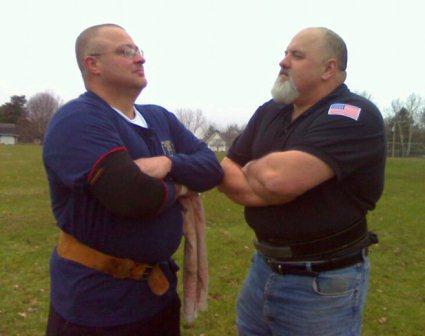
Al Myers (left) and Thom Van Vleck (right) squared off against each other a couple of years ago in a 56# WOB contest, infamously referred to now as the WOB Border War. The rules of the contest required it be a traditional standing toss, in which the spin would not be allowed. I issued this challenge to Thom because I felt he had snubbed the standing toss and everything he once believed in! Chad Ullom served as the official, and due to his incompetence the outcome was questionable as to who had actually won. We each claimed victory, but Chad determined it a tie. (photo credit Chad Ullom)
An answer to this issue would be to only allow the spin in the A class and Pros. The idea being that once you reach that level you should have worked on the technique enough that you would be safe as well as guys capable and have the time to master the style. I do not agree with this, but would go along with this solution.
Third, it is hard on equipment. I have run meets and they are quite expensive. Al Myers made a good point to me that I feel every athlete should hear. On average at a good meet the AD will spend about $100 per athlete. The most I have ever paid for entry is $20. The rest is absorbed through sponsers, gate (which we all know is not great unless you are in a huge games), and straight from the pockets of the AD’s. Plus sweat and toil equity. I personally don’t want to have 3 sets of sheaf standards and WOB standards for back ups because the others are getting tore up. And they will be once everyone starts doing these styles. You run one meet and you will see how tore up the equipment gets and just how expensive it is to fix it back up.
The simple answer would be to make the athletes more financially responsible. Higher entry fees or make them agree to pay for repairs to anything damaged by an errant throw. I don’t want to do this at my meets so I will likely limit the Super A’s to the option of the spins and only if they can demonstrate they have mastered it enough in warm ups they won’t be be a threat to anyone.
While I personally would like to do away with the spinning styles this is not my sport to make demands. I am not a cry baby and will adapt if that is what I have to do. I have just heard so many complaints about it I felt I should lead a charge. If no one follows then I will look foolish (as I have many times before) and walk back and get in line with my fellow athletes to learn the new styles. If you agree, get on the chat rooms, talk to the AD’s, and organizations (NASGA, RMSA, SAAA, SSAA, etc). Let’s make the push to make hard decisions on this matter before it goes too far. Otherwise, it is moving along and until someone get hurt the athletes are going to do whatever it takes to get an edge.
CREDIT: The Braemar Stone Tablet, Volume #3, Issue #2
